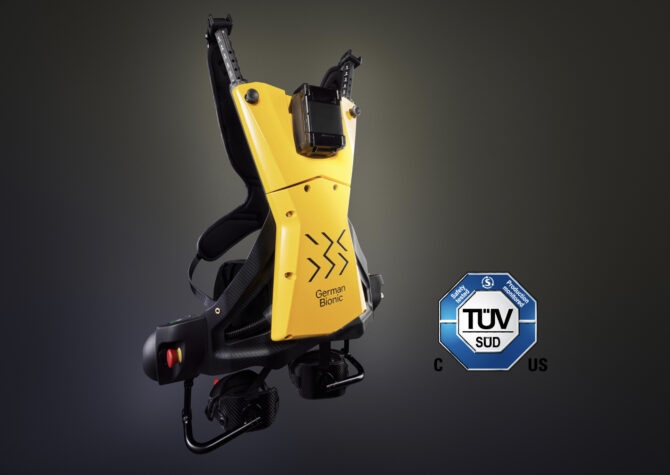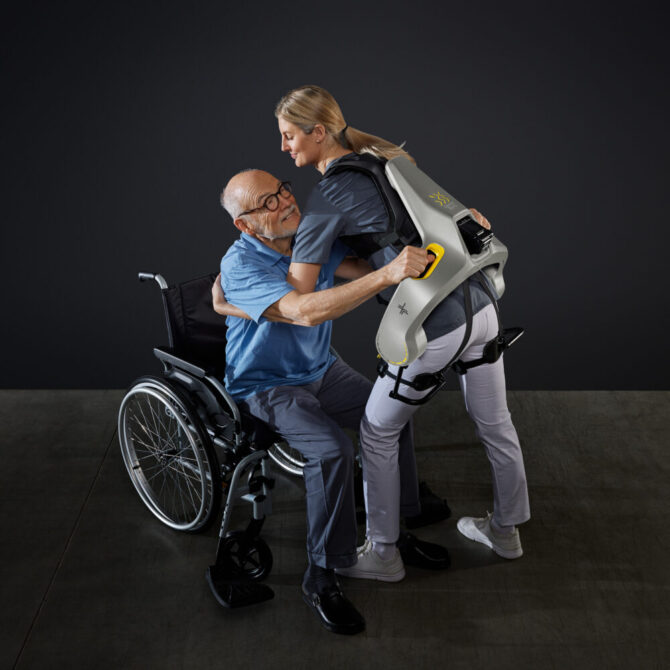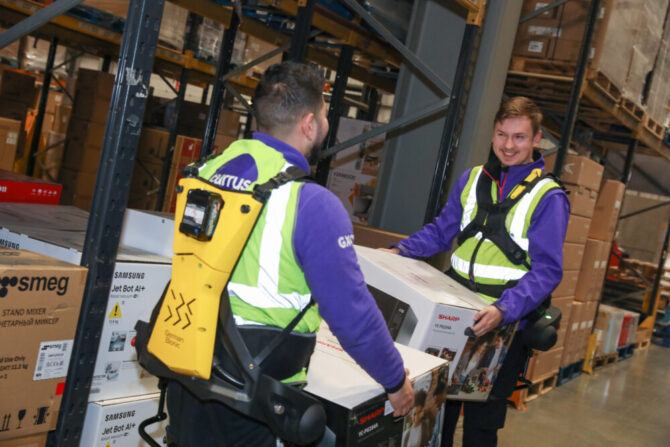
Smart exoskeletons ensure workplace safety
Stephen Law
Automation / Robotics Electronics Engineering Medical Wearable Technology AI-powered Editor Pick exoskeletons German-Bionic robotics smartGerman Bionic design provides wearable tools, ergonomic data insights
According to the global health experts, musculoskeletal disorders (MSDs) affect around 1.71-billion people globally and are the leading contributor to disability worldwide, with low back pain being the single biggest cause. Repeated heavy lifting is an activity that places considerable strain on the musculoskeletal system, which can lead to the development of MSDs. The US Institute of Medicine estimates the economic burden of workplace MSDs as measured by absenteeism, compensation costs, lost wages, and lost productivity being US$ 45 – 54 billion annually in the US alone. And as populations continue to age, these figures will rise.
Enter German Bionic, Europe’s first manufacturer to develop and produce smart exoskeletons that provide wearable tools and ergonomic data insights for workplace safety.
For this article, EP&T interviews Armin Schmidt, CEO and founder of German Bionic, a serial entrepreneur in the field of cloud-based products and services. As co-founder and CEO of German Bionic, Schmidt oversees the development of his firm’s smart wearable tools – such as the award-winning robotic exoskeleton that provides protection against over-exertion and injury for people performing tough physical work.

AI-based exoskeleton supports heavy lifting and walking to improve overall business performance through advanced ergonomics and human augmentation. Source: German Bionic
These ‘smart power suits’ provide mechanical support for lifting and carrying, and use a smart assistance system to alert users, for example, of instances of incorrect lifting or when they should take a break. At the end of the day this means the risk of accident and injury is reduced, which not only makes for happier workers but also more productive employees.
Q. How does German Bionic’s approach differ from other exoskeleton technologies currently available in the market?
Our approach combines active, AI-powered assistance with full connectivity to support lifting movements and walking. Unlike passive exoskeleton systems where the energy first needs to be provided by the users and stored in order to be ready to be released when needed, our active system gives the wearer extra energy by using the power of batteries and robotics motors to amplify the wearer’s own movements. Data collected by the various integrated sensors allows data-driven insights to be continuously gained and used to keep improving and individualizing the user experience while also providing the foundation for AI-based learning.
Q. Workplace safety is a significant concern. How do these smart power suits create safer environments for workers?
Our latest generation of exoskeletons – which includes the Apogee for deployment in logistics, construction, manufacturing and other industrial environments, and the Apogee+ designed specifically for use by caregivers – provides users with 66lbs (30 kg) of assistance per lifting movement as well as active walking support. Over the course of a day, it is not unusual for our exoskeletons to have taken several tons of weight off the backs of those working in physically demanding jobs. Incidentally, the figures on the amount of compensated weight and other figures are reported to the user on the screen at the end of each shift, meaning users always remain aware of just how much assistance they are receiving.
Of course, there are many positive examples of the impact our devices are having in the real world. One of my favorites comes from an airport baggage handler who was completely thrilled that he could now come home and throw his daughter in the air and catch her again after completing a shift – something he hadn’t been able to do without considerable pain for quite some time.

German Bionic’s power suits provide mechanical support for lifting and carrying, using a smart assistance system. Source: German Bionic
Q. What are the key features that make them ‘smart’ and how do they enhance a wearer’s physical capabilities?
At the heart of our innovations is the groundbreaking cloud-based German Bionic IO platform. The system collects data from our exoskeletons in real time, then intelligently analyzes it, applying machine learning and AI to continuously learn and enhance safety effectiveness with the wearer’s every movement. It enables risks and trends to be identified in real time and also facilitates the pinpointing of process optimizations custom to the working environment, just to name two examples. With the integrated Smart Safety Companion early warning system for ergonomics – which alerts, for example, of instances of poor posture, incorrect lifting, and excessive strain – the platform provides comprehensive monitoring and reporting functions as well as individualized recommendations for action based on real, relevant data. Our smart system therefore not only makes occupational health and safety measurable, it also makes it visible.
Q. How do you strike a balance between technology assistance and the user’s natural movements?
The person wearing our exoskeleton is always in charge, and our technology is designed to merely amplify their natural movements. What sets German Bionic apart is our advanced, fully-connected system, which enables it to learn and adapt to the specific movements of each individual user. This level of personalization is unique to our technology. By continuously gathering and analyzing data, our AI-driven system optimizes the exoskeleton’s performance to align seamlessly with the user’s natural biomechanics. This personalized approach not only enhances user comfort and easy adoption, but also maximizes productivity and safety.
Q. How do the wearable exoskeletons blend comfort and functionality?
Comfort is absolutely crucial for ensuring maximum user take-up of wearable devices. This year’s introduction of our Apogee and Apogee+ models represents the release of our sixth exosuit generation. And with each iteration, the user experience has been significantly enhanced. Besides the obvious improvements to the physical design – with lower weight, slimmer form, a new vest and fasteners as well as an ingenious floating back connector, many things that have a big impact on blending comfort and functionality are found in the software and control system and therefore not apparent at first glance. Thanks to being fully connected, we have access to data from hundreds of thousands of hours during which our exoskeletons have been in operation in real work environments. This mass of data matched with AI provides the foundation for continuous improvements and also enables the devices to actually adapt to the individual user. German Bionic is unique in this capability.
Q. What steps have been taken to ensure industry adoption for this new technology?
While exoskeletons in industrial settings may have been a relatively rare sight just a few years ago, today the word is out. Contributing to this has been the speed at which the products have developed, the level of market education, and, of course, a more competitive price point. German Bionic has been instrumental in every step of this development. Since its origins in a research project more than a decade ago and its establishment as a company in 2017, we have seen the interest in and awareness for the German Bionic solutions increase massively across a diverse range of sectors. In fact, it is also one of the reasons why we recently introduced a model dedicated to the needs of caregivers, the Apogee+. While there still might be a need for more education in certain areas, developments like labor shortages and demographic shifts are also increasingly elevating our exoskeletons to ‘must have’ devices to ensures companies can attract and retain the best workers in physically demanding jobs.
Q. Can these products be customized to adapt to specific job requirements?
Yes, that’s a crucial question and one that we attach tremendous importance to. Besides having different leg and chest pieces in sizes ranging from S-XXL, the German Bionic exoskeletons have one special advantage over other types: As mentioned earlier, our power suits are smart and fully connected. This supports flexibility on several levels. First, it means the device knows who is wearing it and how the individual person lifts – along with his or her general preferences and setting. Second, the data collected by the sensors in our Apogee and Apogee+ exosuits is analyzed in real time by the cloud-based platform and can recognize the types of tasks being conducted. And thirdly, the data-based insights gained from new tasks and activities can be exploited to develop new functionalities that can then even be uploaded to the devices OTA.

German Bionic Cray X exoskeletons support the work of staff involved in manual handling tasks, helping to putting less pressure on their joints and muscles while lifting heavy loads and significantly contributing to workplace injury prevention. Source: German Bionic
Q. How does German Bionic address data security and privacy concerns?
Data security and privacy are important issues. With the adoption of the GDPR (General Data Protection Regulation) in Europe in 2016, Europe has some of the most stringent regulations in this regard. Our devices are fully GDPR compliant by design. The data collected by the device is not attributable to an individual person, therefore no data security or privacy issues exist.
Q. Looking ahead, what are German Bionic’s future plans for innovation and expansion? Are there any new features or applications on the horizon?
The global market for exoskeletons is forecast to expand significantly over the coming years – with powered types predicted to be responsible for the majority of this growth. Exoskeletons will soon be the norm in jobs with manual handling and will eventually also become widely available for domestic users. Our strong, established presence in Europe and Japan, and since late 2021 now in North America too, means that we are well placed to help make the lives of people working in physically demanding jobs safer and less strenuous.
And there is more to come. Technology and innovation are in blood. We are fully devoted to pushing the boundaries further and expanding our leading role in robotic exoskeletons and smart wearables. We’re only scratching the surface of what’s possible in the world of human augmentation. Both our Apogee model for industry as well as the Apogee+ for healthcare environments are available now in Canada.
—————————————————–
